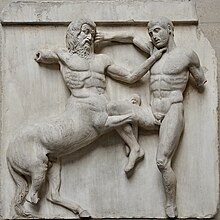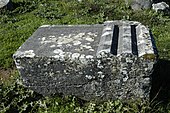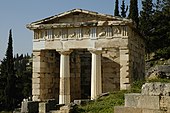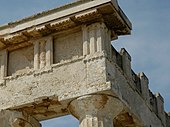Metope

In classical architecture, a metope (μετόπη) is a rectangular architectural element that fills the space between two triglyphs in a Doric frieze, which is a decorative band of alternating triglyphs and metopes above the architrave of a building of the Doric order. Metopes often had painted or sculptural decoration; the most famous example are the 92 metopes of the Parthenon marbles some of which depict the battle between the Centaurs and the Lapiths. The painting on most metopes has been lost, but sufficient traces remain to allow a close idea of their original appearance.
In terms of structure, metopes may be carved from a single block with a triglyph (or triglyphs), or they may be cut separately and slide into slots in the triglyph blocks as at the Temple of Aphaea. Sometimes the metopes and friezes were cut from different stone, so as to provide color contrast. Although they tend to be close to square in shape, some metopes are noticeably larger in height or in width. They may also vary in width within a single structure to allow for corner contraction, an adjustment of the column spacing and arrangement of the Doric frieze in a temple to make the design appear more harmonious.
Gallery
-
A metope (L) and triglyph (R) cut from one block from Stratos
-
Triglyph blocks with slots for the insertion of metopes in the Marmaria at Delphi
-
Metopes made from marble slotted into the frieze of the Stoa at Brauron
-
Section of metope frieze from a temple near Paestum, c. 510 BC
-
Metopes with sculptural decoration in the Doric frieze of the Treasury of the Athenians at Delphi
-
Frieze of the Temple of Aphaea with triglyphs slotted for metopes
-
The entablature of the Hephaisteion (temple of Hephaistos) in Athens, showing Doric frieze with sculpted metopes
-
Early 20th century Americanized metopes, using bison in place of cow skulls (bucranium)
See also
References
- Robertson, D. S. (1929). Handbook of Greek and Roman Architecture. Cambridge: Cambridge University Press.
External links
 Media related to Metopes at Wikimedia Commons
Media related to Metopes at Wikimedia Commons








